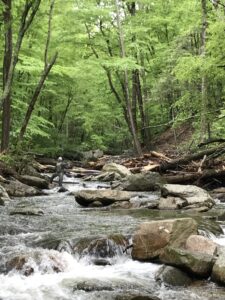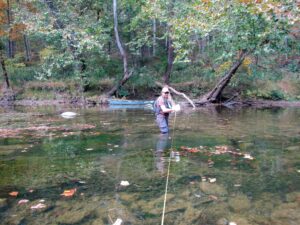Streams and Rivers
Interstate Commission on the Potomac River Basin
What’s in a Watershed?
 Aquatic communities in streams and rivers depend on stable riparian buffers and floodplains, favorable water quality, natural flow patterns, and adequate instream habitat to successfully perform their various ecological roles. Ecological studies investigate relationships between aquatic communities and their environments and often precede decisions on whether to list a water body as impaired.
Aquatic communities in streams and rivers depend on stable riparian buffers and floodplains, favorable water quality, natural flow patterns, and adequate instream habitat to successfully perform their various ecological roles. Ecological studies investigate relationships between aquatic communities and their environments and often precede decisions on whether to list a water body as impaired.
- West Virginia Algae Surveys, 2012-2018: Filamentous green algae blooms in the Cacapon and South Branch rivers and the West Virginia portion of the Shenandoah.
- Cacapon and Lost River Studies
- Hydrologic Alteration: When does anthropogenically altered streamflow begin to impact macroinvertebrate communities?
- Nutrient Thresholds: Excess nutrients will fuel plant and algal production and sometimes lead to harmful algal blooms that damage ecosystems and endanger people and animals.
Hydrologic Alteration
Using the Ecological Limits of Hydrologic Alteration (ELOHA) framework (Poff et al. 2010), ICPRB developed flow alteration-ecological relationships for combinations of six flow metrics and seven macroinvertebrate metrics.
The study area was the large, topographically complex central region of the Potomac River basin. Stream macroinvertebrates there respond strongly to changes in the duration and frequency of both high and low flow events, rise rate, flashiness, and the magnitude of high flow events. They do not respond to alteration in middle- and low-magnitude flow metrics, fall rate or extreme low flow frequency. Of the seven macroinvertebrate metrics, percent scrapers, percent clingers and the Chessie BIBI were most affected by flow alteration.
Degraded habitat and water quality conditions modify and, if strong enough, conceal the flow alteration–ecological relationships. Overall, the ELOHA approach appears to have worked well in a large river basin with complex topography, karst geology, few flow-altering dams, many urban areas and macroinvertebrates as the ecological response variables.
Buchanan, C., H. Moltz, H. C. Haywood, J. B Palmer, and A. N. Griggs. 2013. A test of the Ecological Limits of Hydrologic Alteration (ELOHA) method for determining environmental flows in the Potomac River basin, U.S.A. J. Freshwater Biology 58(12):2632-2647. https://doi.org/10.1111/fwb.12240.
This publication was an outcome of the Middle Potomac River Watershed Assessment: Potomac River Sustainable Flow and Water Resources Analysis.
Nutrient Thresholds
 ICPRB is helping to determine phosphorus and nitrogen thresholds above which stream and river ecosystems are more likely to degrade. In a 2011 analysis, periphyton, phytoplankton, and macroinvertebrates responses to nutrients were studied using recursive partitioning (Category and Regression Tree). Nutrient thresholds appeared once the influences of key confounding factors were accounted for. A spectrum of disturbance categories could then be constructed, with best conditions at one end (low nutrients, favorable stream conditions) and worst conditions at the other end (very high nutrients, degraded stream conditions). These disturbance categories strongly resemble the disturbance gradients (level of exposure to combined stressors) used to develop Biological Condition Gradients.
ICPRB is helping to determine phosphorus and nitrogen thresholds above which stream and river ecosystems are more likely to degrade. In a 2011 analysis, periphyton, phytoplankton, and macroinvertebrates responses to nutrients were studied using recursive partitioning (Category and Regression Tree). Nutrient thresholds appeared once the influences of key confounding factors were accounted for. A spectrum of disturbance categories could then be constructed, with best conditions at one end (low nutrients, favorable stream conditions) and worst conditions at the other end (very high nutrients, degraded stream conditions). These disturbance categories strongly resemble the disturbance gradients (level of exposure to combined stressors) used to develop Biological Condition Gradients.
Data Analysis to Support Development of Nutrient Criteria for Maryland Free-Flowing Waters (ICPRB Report 11-2)
Return to Aquatic Life Main Page

